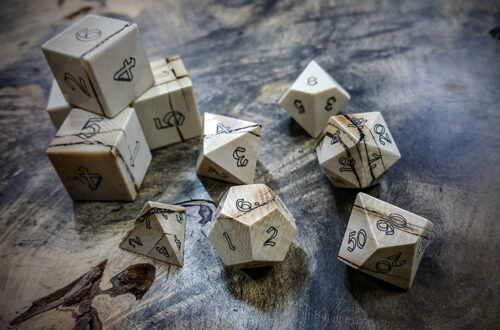Enter the Dungeon
Just a few days ago, Wizards released the primer and dates for the new edition of Dungeons and Dragons, and it turns out they are doing a few things different this time around.
The schedule is below.
Dungeons & Dragons Starter set: July 15th
Players Handbook: August 19th
Adventure: Hoard of the Dragon Queen (Forgotten Realms): August 19th
Monster Manual: September 30th
Adventure: Rise of Tiamat: October 21st
Dungeon Master’s Guide: November 18th
First off, they are staggering releases, which seems to be a cursed blessing. While it gives them time to work on each book individually, it will lead to some problems playing games as we wait for each book to come out.
I like this because, hopefully, this will allow them to get the books right. Keeping up with the 4e errata was so cumbersome that we didn’t even try. this should be a much cleaner release.
They are, however, going to be expensive book, clocking in at a hefty 49.99 per core book. I dunno that I am willing to “give it a whirl” at that price, and might end up borrowing the book from some friends on the internet.
They are also releasing, again, a miniatures line. Again, they are making the colossal mistake of having them be random. I’m not even going to link them, they are so worthless.
I’m really excited for this next edition, but it could be that I’m just a D&D nerd. I’ve played every edition that has been, and enjoyed them all in their own space.
I started playing with AD&D, and in about a year and a half, moved on to AD&D: Second edition. I played that for about 6 months, and then we started warping it into what we wanted an RPG to be. By the time we were finished with 2e and moving onto 3.0, it was unrecognizable as the same game system, but we loved it. We slowly embraced 3.0, and only really switched over at the time that 3.5 released. 3.5 was both a blessing and a curse, as it was full of options, but swiftly became bloated and felt heavy under its own weight, eventually bursting. 4e came along, and I played that for a good long while, but its lean towards miniatures combat and lack of story elements was a real downer. As soon as the playtest was released, it pretty much spelled the end of our 4e relationship, and we ended up playing Gamma world and the IKRPG.
I read and scoured the Playtest rules for “next” every time they came out, and though the early ones grabbed me stronger, I don’t really mind where they, supposedly, ended up, and at the very least am willing to try it. Its what I have been waiting for for my Against the Giants run, and am glad that its going to be “soon.” I look forward to smashing my players to death with a new ruleset!!
On Thursday, they were also at a little convention called ACD games Day, and tons of people sent in information to EN World. Much of the information is good but unclear, but there are a few really useful pieces.
- The Starter box is for DM’s to be able to run adventures, so there won’t be character creation information in them.
- Character creation information, however, will be available in downloadable forms on day 1, as will about 15% of the PHB, allowing you to bridge the gap until the PHB comes out.
- You will supposedly be able to run a complete campaign in August from the resources available to you.
- The final Playtest rules are very similar. They added Warlock and Sorcerer, and pulled warforged to the DMG
They even did an interview with Kobold Press.
For me, the best tidbit from the interview is this precious nugget.
What parts of designing for the next edition of D&D made you rub your hands with glee? What does it do in a way that makes it easier, or more fun, for you as an adventure designer?
Steve: Every new edition of D&D—but 3rd and 4th especially—has moved the game in the direction of greater codification. More and more gets specified in terms of “this is how it must be” and less and less is left in the hands of the players and the DM to interpret or develop on their own.
The new edition of D&D seems to be shifting the balance in the opposite direction. It’s stepping back toward a philosophy of saying, “You DMs and players are smart people—the rulebook doesn’t need to tell you how to do every little thing. Here’s a framework for modelling fantasy. Do what you want with it.” There’s a lot more specificity than there was in, say, OD&D or D&D Basic/Expert, but there’s considerably more freedom than there was in 3rd and 4th edition.
As an adventure writer, that’s tremendously liberating. Instead of spending all my mental energy figuring out the optimal spacing between foes or tightly scripting the precise order in which a monster will use each of its five special abilities, I can focus on plot and motivation. I can tell the DM, “The villain wants to accomplish this, but he’ll run away if this happens,” and leave it to the DM to handle that situation intelligently. That’s better for me as a writer, and frankly, I think it’s better for the DM, too.
As both a DM and a player, that makes me really thrilled. One of the major problems, as he touched on, with the latest two editions was the rules creep, and hopefully that’ll be solved and we can return to a more creatively oriented version of Dungeons and Dragons.
I’m definitely going to put the game through its paces when I run Against the Giants, so I’ll have more info as I get into converting the game from its ancestor 2e into the current 5e.

